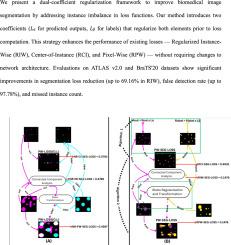一种用于减少生物医学图像分割中实例不平衡的损失函数正则化方法
IF 3.1
4区 生物学
Q2 BIOLOGY
引用次数: 0
摘要
在过去的二十年里,生物医学图像分割的应用得到了迅猛的发展。当前最先进的方法在处理数据集中的实例不平衡时面临挑战。各种功能,如Blob Loss、病变-wise Loss和骰子- Loss限制,通过实例-wise Loss和实例中心-of- instance Loss (ICI)解决。ICI是实例损失的结果,而实例损失中心的标签和输出高度不规范,导致上述损失函数的准确性较低。我们引入了一种新的双系数正则化方法,在损失计算之前修改预测输出和标签。这比以前的像素级或类级加权策略更有效地解决实例不平衡问题。提出的方法增强了现有的损失函数:(1)RIW(正则化实例损失),(2)RCI(正则化实例中心损失)和(3)RPW(正则化像素损失)。在ATLAS R2.0 (MICCAI, 2022)和BraTS ' 20 (MICCAI, 2020)数据集上的仿真实验验证了我们的方法,与最先进的损失函数相比,RIW(高达69.16%)、RCI(高达16.58%)、RPW(67.82%)显著提高,随后降低了误检率(高达97.78%),并减少了漏检实例的数量。本文章由计算机程序翻译,如有差异,请以英文原文为准。

A novel regularization approach for loss functions to reduce instance imbalance in biomedical image segmentation
Biomedical Image Segmentation applications have witnessed mushroom growth in the last two decades. Current state-of-the-art approaches face challenges when dealing with instance imbalances in datasets. Various functions, such as Blob Loss, Lesion-wise Loss, and Dice Loss limitations, were addressed by Instance-wise loss and Center-of-Instance loss (ICI). ICI is the result of Instance loss, and the center of instance loss suffers from highly unregulated labels and outputs, resulting in low accuracy of aforementioned loss functions. We introduce a novel dual-coefficient regularization approach for loss functions that modifies both predicted outputs and labels before loss computation. This addresses instance imbalance more effectively than previous pixel-level or class-level weighting strategies. The proposed approach resulted in the enhancement of existing loss functions: (1) RIW (regularized instance-wise loss), (2) RCI (regularized center of instance loss), and (3) RPW (regularized pixel-wise loss). The simulation experiments on the ATLAS R2.0 (MICCAI, 2022) and BraTS’20 (MICCAI, 2020) datasets validated our approach in comparison with the state-of-the-art loss functions resulting in significant improvements in RIW (up to 69.16%), RCI ( up to 16.58%), RPW (67.82%), subsequently decreased false detection rate up to (97.78%), and number of missed instances.
求助全文
通过发布文献求助,成功后即可免费获取论文全文。
去求助
来源期刊

Computational Biology and Chemistry
生物-计算机:跨学科应用
CiteScore
6.10
自引率
3.20%
发文量
142
审稿时长
24 days
期刊介绍:
Computational Biology and Chemistry publishes original research papers and review articles in all areas of computational life sciences. High quality research contributions with a major computational component in the areas of nucleic acid and protein sequence research, molecular evolution, molecular genetics (functional genomics and proteomics), theory and practice of either biology-specific or chemical-biology-specific modeling, and structural biology of nucleic acids and proteins are particularly welcome. Exceptionally high quality research work in bioinformatics, systems biology, ecology, computational pharmacology, metabolism, biomedical engineering, epidemiology, and statistical genetics will also be considered.
Given their inherent uncertainty, protein modeling and molecular docking studies should be thoroughly validated. In the absence of experimental results for validation, the use of molecular dynamics simulations along with detailed free energy calculations, for example, should be used as complementary techniques to support the major conclusions. Submissions of premature modeling exercises without additional biological insights will not be considered.
Review articles will generally be commissioned by the editors and should not be submitted to the journal without explicit invitation. However prospective authors are welcome to send a brief (one to three pages) synopsis, which will be evaluated by the editors.
 求助内容:
求助内容: 应助结果提醒方式:
应助结果提醒方式:


